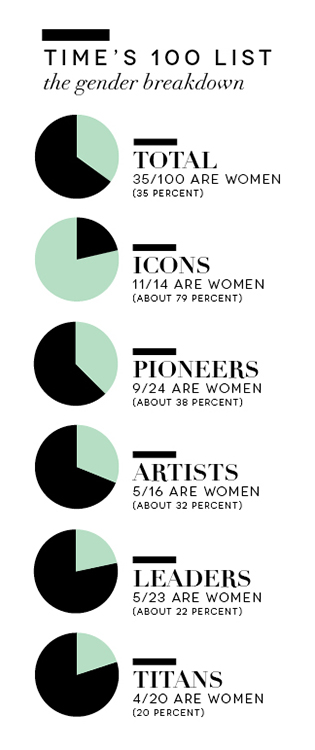Beyoncé photo by José Goulão
A guest column written by Megan Pearl.
Time Magazine came out with their annual 100 most influential people, 35 of whom are women. While I think the disparity between representatives of men and women on the list is troubling, the categorization may prove worse in reinforcing negative gender stereotypes.
The gender breakdown by category is as follows:
The women who made the list are predominantly sorted into the “Icons” category. What does it mean to be an icon? Well, my first thought associations are women like Audrey Hepburn and Marilyn Monroe: Women who are more their image than their actions. Marked by their romanticized style and beauty, they are over-photographed, reproduced to a cliché, and representative of—I’m not really sure what they represent actually. But I know many women with books, posters, and Pinterest boards dedicated to their seemingly classy, ultra-feminine, everything-a-girl-should-be reputations.
I think “icon” denotes this sense of something to be looked at, and this is specifically different from what “titans” means in this cultural context. When we categorize women as being influential because they are “icons,” it automatically deducts from what they do and puts emphasis on what they represent.
Furthermore, is it just a coincidence that their “Titans” category has the lowest number of women listed, but implies the most powerful, active, incredible of the bunch? It doesn’t sit well with me that Jay Z is listed as an artist and entrepreneur under “Titans” when Beyonce is listed as a diva under “Icons.” Jay Z’s profile, written by Michael Bloomberg, is an ode to the American Dream. Baz Luhrman wrote Beyonce’s profile, and he focuses on her ability to perform, her devotion to her family, and her ability get everyone’s attention.
Maybe this is going to sound naïve or nationalistic, but I want to have confidence that America is one of the best countries in the world. But for all of our pros, gender inequality is still a major con. South Korea’s President, Park Geun-hye, was one of the five women to make the “Leaders” category. Yingluck Shinawatra writes a particularly profound line in her profile: “Female leaders are often tested in ways that men are not.” Just between maintaining a socially acceptable, feminine shell and getting shit done, it has to be difficult. I just think of Hillary Clinton’s rebuttal to a question about her favorite designers, “Would you ever ask a man that question?”
Probably not.
For all of the American emphasis on equality, we still haven’t had a woman serve as President of our nation. In fact, women are severely underrepresented in American politics as a whole. According to the Center of American Women in Politics, there has been a less than 5 percent increase in women serving as elected officials or representatives since 2001. The average numbers hover around 20 percent.
Now we arrive at this chicken or the egg kind of issue: Are women underrepresented in influential positions because the overwhelming message is that they can’t or don’t, or do women reinforce that cultural, media message because they can’t or don’t participate?
Sheryl Sandberg, listed as one of the few female “Titans,” suggests it’s the fault of women making decisions to hold themselves back before they even begin. But women are taught to be scared that they are missing out. How many times have we seen that obnoxious cultural adage, “Can women have it all?” Of course, the question implies whether a woman can afford the life choice of fulfilling women’s domestic duties on top of some extra curricular career. Gloria Steinem writes in Sandberg’s profile, “Among her most radical suggestions is that if a woman wants children, her most important career decision is who her partner is, and if a man wants children, he could also raise them.” Sandberg suggests women should pursue their careers, find partners who support them, and address the issue of children when it actually comes up. Perhaps it’s her aggressive manner of telling women to “lean in” that earns her place in the “Titans” category.
There also seems to be a pattern in the women American culture places value on. Western women are valued for their style or fame—how they entertain the public. The Southern and Eastern women on the list are linked to social activism or leadership. It’s reminiscent of the media theory proposed by Cedric Clark that minorities are introduced into mass media in a progression of four stages: Non-recognition, Ridicule, Regulation, and Respect. My understanding of Regulation is like how on “Law and Order” and similar shows, there is often a black woman portraying the judge or some other symbol of authority and stability. American media seems to have trapped the majority of women in the Regulation stage: either adhering to social norms by being an entertainer who meets feminine criteria, or they’re leaders and activists in other countries that have reputations of being less fair and developed than how we envision America.
When major institutions like TIME give us a list of the most powerful, influential, and whatever other superlative their editorial boards think of, they have to be read with a critical eye. Their categories were unnecessary and insulting, but perhaps useful in giving a perspective of the dominant thought on how society sees women.
Megan is somewhere between an aspiring raw vegan and cheeseburger enthusiast. Hobbies include eating, drinking, and marathons of TV watching on Netflix. She enjoys writing/thinking/talking about the way people are represented in the media and subverting the patriarchy. Her pride and joy is a pet rabbit who goes by Bun Bun.





